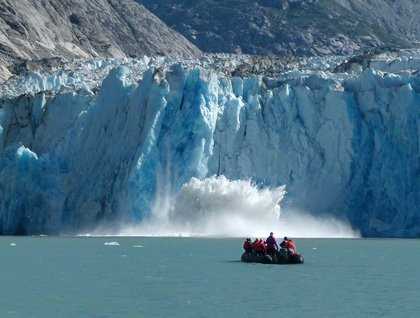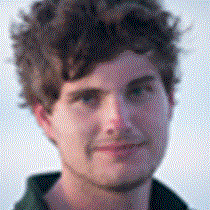Alaska is known for its grandeur, glaciers, and wildlife, and today we experienced a marvelous introduction to all three. We awoke near the head of Endicott Arm within a wilderness area in Tongass National Forest. No houses or docks were visible. There were no roads. As far as we could see, there was no sign of human activity on shore. The wildness here is hard to grasp. Immense cliffs towered above the National Geographic Sea Bird as the officers deftly maneuvered her through chunks of floating ice towards the jagged face of Dawes Glacier, which at one time filled the entire fiord and covered almost all of the mountains around us.
We boarded our trusty expedition landing craft after breakfast to investigate the ice, waterfalls, and surrounding terrain in closer detail. Bright sunlight glinted across the luminous blue bergy bits, but it was still fairly chilly from cool winds rolling down the glacier towards us. Each group of travelers saw slightly different things on our outings. Harbor seals poked their shiny round heads above the surface to watch us pass. We steered clear of those hauled out on the ice to avoid disturbing their naptime. Two harbor porpoises circled our boats and even raced alongside the bow, behaviors very uncommon for these rather shy creatures. The glacier itself was magnificent, with precarious spires called seracs rising from the sea, poised to collapse at any moment. Glacier watching requires patience. One can wait for hours and see no real changes or be lucky and see giant slabs of ice fall all at once from the face. We had some of both. A spectacular calving event generated rolling swells that gently rocked the little boats and the ship itself for several minutes. While we enjoyed the glacier, a boat arrived with crew to serve us hot chocolate and whipped cream. What a treat! Eventually all returned to the Sea Bird to follow the fjord out to its mouth and into the larger body of water known as Stephen’s Passage.
It was a lovely afternoon to relax as we motored through the flat calm sea. Marbled Murrelets, gulls, and other seabirds caught our attention, and we spotted two Long-tailed Jaegers, a species common in the interior where they nest but not often seen in the quiet waters of Southeast Alaska. Salmon leaped clear of the surface, and Dall’s porpoises rose slowly here and there in the distance.
After an informative talk by our photo instructor, an announcement came over the PA that a humpback whale had been spotted. We gathered on deck to view this baleen whale spout and fluke repeatedly. Humpbacks in this region typically swim all the way to Hawaii to spend part of the year, and then return to Alaska to take advantage of summer feeding opportunities. We continued on through a calm sea past snow-capped peaks on the horizon with scenic vistas on all sides. Our first full day on the ship was a perfect introduction to the wildness of Southeast Alaska.









